Unravel the Enigmatic Responses of Cats to Catnip: A Comprehensive Exploration of Feline Behaviour
Diving into the Enigma of Catnip Responses: Understanding our beloved feline companions encompasses a myriad of intriguing subjects, and their reactions to catnip stands out as particularly captivating. This humble herb possesses an extraordinary ability to transform even the most introverted cats into lively, playful creatures. To truly grasp this fascinating occurrence, it is essential to investigate the underlying biochemical mechanisms, observe the varied responses across different cats, and assess the intensity and duration of these enchanting effects.
Understanding the Chemistry of Catnip: Exploring Nepetalactone and Its Influence on Feline Behaviour

At the core of this delightful phenomenon is a compound known as nepetalactone, which is found in abundance within the leaves, stems, and seeds of the catnip plant, scientifically referred to as Nepeta cataria. Upon encountering catnip, cats instinctively respond by sniffing, licking, or chewing it, which releases nepetalactone into their bodies. This compound interacts with specialised receptors in the feline nose, activating sensory neurons and inducing a state of euphoria and heightened excitement.
Research indicates that nepetalactone bears a striking resemblance to certain compounds found in cat pheromones, resulting in a blend of exhilarating and calming effects on felines. The response to Catnip varies significantly, often manifesting in behaviours such as rolling, purring, and playful antics as cats become entranced by the alluring aroma. Interestingly, the response to catnip is not uniform; approximately 50% to 75% of cats demonstrate a reaction, influenced by genetic factors. Those who do not react may lack the specific receptors required to detect nepetalactone, highlighting the intriguing diversity within feline behaviour.
Understanding Variability in Catnip Sensitivity: Why Do Some Cats React Differently?
Not every cat displays enthusiasm for catnip, and this variability stems from a blend of genetic predispositions and environmental factors. Some cats inherit the capacity to respond to catnip, while others may remain indifferent. Kittens, specifically, often show no interest in catnip until they reach certain developmental milestones, usually around six months of age, at which point they begin to develop the necessary receptors to respond effectively.
Beyond genetic makeup, the unique personality of each cat greatly influences their response to catnip. Some may become exuberantly playful, while others may experience a sense of calm and contentment. This range of temperaments produces a delightful array of behaviours, underscoring the importance of recognising your cat’s individual preferences to enhance their overall quality of life.
Examining the Duration and Intensity of Catnip Reactions: Factors That Influence Cats' Responses
The effects of catnip are typically transient, lasting approximately 10 to 15 minutes. Following this initial surge of excitement, cats often appear temporarily indifferent to the plant's scent—a phenomenon referred to as “catnip fatigue.” This temporary desensitisation can persist for several hours before a cat may exhibit a response to catnip once more.
Various factors can impact the intensity of a cat’s reaction to catnip. These elements encompass the freshness of the herb, the method of exposure, and the individual cat’s mood at the time of interaction. Fresh catnip, particularly when cultivated in home gardens, generally provokes a more robust response compared to dried alternatives. Moreover, the manner in which catnip is presented—whether within toys, sprays, or simply scattered on the floor—can significantly influence a cat's level of engagement. Understanding these nuances allows cat owners to tailor their methods, ensuring that their feline companions enjoy the most fulfilling experiences with catnip.
Enhancing Your Cat's Life with Catnip: Practical Applications and Benefits

Catnip transcends mere entertainment; it plays a crucial role in enhancing the lives of our cats. From encouraging playful activity to alleviating stress, the applications of catnip for improving feline well-being are both diverse and impactful.
Boosting Playtime Activity: Effective Ways to Use Catnip for Increased Engagement
Integrating catnip into playtime can significantly elevate a cat’s activity levels and engagement. The excitement generated by catnip can transform a routine play session into an exhilarating adventure. When cats interact with catnip-infused toys, they often exhibit behaviours such as pouncing, chasing, and rolling, which not only provide physical exercise but also stimulate their cognitive faculties.
For optimal engagement, cat owners should consider regularly rotating their catnip toys to maintain novelty and interest. Adding fresh catnip to existing toys can reignite enthusiasm, prompting cats to actively explore and play. This strategy is particularly advantageous for indoor cats, who may lack access to the diverse stimuli available outdoors. By crafting an enriching play environment, we can help mitigate boredom and reduce the likelihood of destructive behaviours.
Soothing Anxious Felines: Harnessing Catnip for Stress Relief
For cats experiencing anxiety—whether due to environmental changes, loud noises, or other stressors—catnip can serve as a natural calming agent. The euphoric response triggered by nepetalactone can act to distract and soothe a cat, providing comfort during stressful periods.
When introducing catnip for relaxation, it is crucial to monitor your cat’s reaction. While some cats may become more tranquil, others might exhibit bursts of energy. Providing catnip in a tranquil setting, away from stressors, can create an environment conducive to relaxation. Additionally, combining catnip with other calming techniques—such as soft music or gentle petting—can enhance its effectiveness, fostering a serene atmosphere for our cherished pets.
Using Catnip as a Training Aid: Encouraging Positive Behaviour in Cats

Catnip can also be utilised as a valuable tool for training and modifying feline behaviours. For example, using catnip can encourage your cat to use a scratching post instead of your furniture, effectively redirecting their natural instincts. Sprinkling catnip on a scratching post can entice a cat to interact with it, reinforcing the desired behaviour.
Moreover, catnip can be employed as a reward during training sessions to foster positive associations and encourage cats to learn new commands or tricks. This method proves particularly effective for reinforcing behaviours that may be challenging to instil, such as consistent litter box usage or acclimatising to a new environment. By creatively employing catnip as a training aid, we can strengthen our bonds with our feline companions while nurturing a harmonious household.
A Comprehensive Guide to Catnip Products: Making Informed Choices for Cat Owners
As interest in catnip continues to flourish, so too does the variety of products available for cat owners. Understanding the different types of catnip products can assist you in selecting the most suitable options for your feline friend.
Exploring Catnip Toys: Diverse Options and Their Benefits
Catnip-infused toys come in a wide range of shapes and sizes, from cuddly plush mice to durable balls, catering to various play styles. These toys not only provide physical stimulation but also activate a cat’s natural hunting instincts. The captivating scent of catnip encourages playful behaviour, making these toys a favourite among many felines.
When choosing catnip toys, it’s essential to consider your cat’s unique preferences. Some cats may favour soft toys they can snuggle with, while others might enjoy toys that they can swipe around. Regularly rotating these toys can help maintain your cat’s interest, ensuring they remain engaged in play. Additionally, opting for high-quality toys made from safe materials enhances both the play experience and your cat’s safety.
Utilising Catnip Sprays and Rubs: Safe and Effective Applications
Catnip sprays and rubs provide a convenient means of introducing the benefits of catnip without the mess associated with loose leaves. Sprays can be applied to scratching posts, toys, or even bedding, increasing their attractiveness and promoting interaction. When using catnip sprays, it is imperative to select products specifically formulated for cats to ensure their safety and non-toxicity.
To effectively utilise catnip sprays, apply them sparingly and allow the surfaces to dry before permitting your cat to engage. This approach prevents overwhelming your cat with an overpowering scent and allows for a more controlled introduction. Furthermore, it is wise to test your cat’s reaction to the spray in a small area before widespread application to ensure they respond positively.
Growing Your Own Catnip: Tips for Cultivating Catnip at Home
For those who favour a hands-on approach, cultivating your catnip can be a fulfilling venture. Fresh catnip not only offers a superior aromatic experience for your cat but also allows you to ensure it is grown free from harmful pesticides and chemicals.
Catnip can be grown in pots indoors or in outdoor gardens, flourishing in well-drained soil with ample sunlight. This hardy perennial adapts well to various climates, making it accessible to numerous gardeners. Regular harvesting encourages bushier growth, ensuring a steady supply for your cat. Whether you opt to dry the leaves for future use or provide them fresh, cultivating catnip can be a rewarding way to enrich your cat’s life while enjoying the pleasures of gardening.
Ensuring Catnip Safety: Essential Guidelines for Responsible Cat Owners
While catnip is generally safe for felines, it’s crucial to be aware of potential safety concerns and precautions to ensure your cat’s well-being.
Recognising Overuse: Identifying Signs of Excessive Catnip and Prevention Methods
As with many aspects of pet care, moderation is paramount regarding catnip. Overexposure can lead to diminished effects, causing a cat to become desensitised to the herb and resulting in reduced or absent reactions. Furthermore, excessive consumption may trigger gastrointestinal issues, including vomiting or diarrhoea.
To prevent overuse, it is advisable to limit catnip sessions to a few times each week. Monitoring your cat’s behaviour during and after exposure can help you assess their responses and make necessary adjustments. If you observe any signs of distress or discomfort, it is best to discontinue use and consult your veterinarian for guidance.
Identifying Allergic Reactions: Managing Catnip Allergies in Your Feline
Though uncommon, some cats may develop allergies to catnip. Symptoms can manifest as itching, excessive grooming, and respiratory issues such as sneezing or coughing. If you suspect your cat is allergic, it’s crucial to cease using catnip immediately and consult your veterinarian for further evaluation.
Carefully observing your cat’s reaction to catnip can assist in identifying any adverse effects. Should allergies occur, your veterinarian may suggest alternative enrichment options that provide similar benefits without the associated risks.
Understanding Interactions with Other Substances: Guidelines for Combining Catnip with Other Supplements
As cat owners explore various enrichment options, it’s vital to exercise caution regarding the combination of catnip with other substances. While catnip is generally safe, mixing it with supplements or medications can lead to unpredictable effects. Always consult your veterinarian before introducing new products alongside catnip, ensuring the safety and well-being of your feline companion.
Moreover, understanding how different substances interact can help you create a balanced enrichment plan that supports your cat’s health. By prioritising safety, you can confidently incorporate catnip into your cat’s life, enhancing their happiness and overall well-being.
Delving into Historical and Cultural Perspectives on Catnip
The appeal of catnip extends beyond contemporary households; its rich history is intricately linked with various cultures and traditions.
Ancient Applications of Catnip: A Historical Overview of Catnip’s Role Across Civilisations
Historically, catnip has been valued not only for its effects on cats but also for its medicinal properties for humans. In ancient civilisations, catnip was employed in herbal medicine to treat ailments such as insomnia and digestive disorders. The Greeks and Romans recognised its calming effects, often integrating it into their herbal remedies.
In addition to medicinal uses, catnip was believed to possess protective qualities against malevolent spirits and was employed in various rituals and folk traditions. This historical context enriches our understanding of catnip, highlighting its significance in the lives of both humans and felines throughout history.
Mythology and Folklore Surrounding Catnip: Cultural Beliefs and Their Influence
The folklore surrounding catnip is rich with narratives reflecting its mystical qualities. Numerous cultures believed that catnip could enhance a cat’s intuition or even grant them supernatural abilities. In medieval Europe, it was thought that cats consuming catnip could perceive and communicate with spirits, adding an enchanting dimension to this remarkable plant.
These tales contribute to the cultural significance of catnip, framing it as a bridge between the natural and mystical realms. Understanding these beliefs can deepen our appreciation for catnip and its enduring place in the hearts of cat lovers and their feline companions.
Modern Cultural References: The Influence of Catnip in Popular Media and Public Perception
In contemporary culture, catnip has permeated popular media, often depicted as a magical substance that brings joy and chaos to the lives of cats. From animated shows to viral social media posts, the amusing antics of cats under the influence of catnip have become a cherished theme, resonating with audiences worldwide.
These portrayals not only entertain but also contribute to a broader understanding of the joys and quirks of cat ownership. By highlighting the delightful effects of catnip, popular media plays a significant role in shaping public perception, encouraging cat owners to explore the benefits of this unique herb for their pets.
Investigating Alternatives to Catnip: Broaden Your Cat's Enrichment Options
While catnip remains a beloved staple for many cats, exploring alternatives and complementary options can further enrich your cat’s experience.
Alternative Herbs and Plants: Discovering Options Such as Silver Vine and Their Effects on Cats
For cats that do not respond to catnip, other herbs like silver vine and valerian root can provide similar stimulating effects. Silver vine, in particular, has been shown to elicit reactions in cats that are unresponsive to catnip, making it an excellent alternative. Its unique compounds can inspire playful behaviour, offering new pathways for enhancing a cat’s environment.
Incorporating these alternatives can diversify your cat’s sensory experiences, ensuring they remain engaged and stimulated. When introducing new herbs, it is important to closely monitor your cat’s reactions to ensure they enjoy the benefits without experiencing any adverse effects.
Combining Catnip with Other Enrichment Tools: Creating a Comprehensive Environment for Feline Enrichment
Crafting a well-rounded enrichment environment entails blending catnip with various tools and activities that stimulate a cat’s mind and body. Integrating scratching posts, climbing structures, and interactive toys alongside catnip-infused products can create a dynamic space for your cat to explore.
Consider designing different zones within your home, each offering unique experiences. For instance, you might establish a play area with catnip toys, a calming zone with soothing scents, and an activity corner featuring climbing structures to cater to your cat’s diverse needs. This holistic approach enhances their overall well-being, providing ample opportunities for exploration and play.
DIY Catnip Projects: Creative Methods to Craft Catnip-Infused Items for Your Cat
For the inventive cat owner, engaging in DIY catnip projects can be both enjoyable and fulfilling. From sewing catnip pillows to baking catnip-infused treats, these projects allow you to personalise your cat’s enrichment experience while utilising fresh or dried catnip.
Simple sewing tasks, such as creating small pouches filled with catnip, can provide hours of entertainment for your feline friend. Alternatively, baking treats that incorporate catnip can delight both your cat’s taste buds and playful instincts. Participating in these creative activities strengthens your bond with your cat while ensuring they enjoy fresh, customised catnip experiences.
Tackling Common Questions About Catnip: Providing Clarity for Cat Owners
As with any aspect of pet care, cat owners often have questions regarding the use of catnip. Here, we address some common concerns to provide clarity and guidance.
When Do Kittens Start Reacting to Catnip?: Understanding the Age of Interest
Kittens typically do not respond to catnip until they reach around six months of age. Their sensory receptors, which are not fully developed before this age, prevent them from exhibiting the playful behaviours associated with catnip. Once they mature, many cats will begin to demonstrate interest, leading to delightful displays of playful antics.
Introducing catnip at the appropriate time can enhance their play experiences, but it’s essential to wait until they are developmentally ready. Patience is key as you anticipate their initial reactions to this enchanting herb.
Is Catnip Addictive?: Debunking Misconceptions About Catnip’s Addictive Nature
Many cat owners express concern about the potential for catnip to be addictive. However, the reality is that catnip is not physically addictive. While cats may exhibit strong reactions to catnip, this response is temporary and does not lead to compulsive behaviour.
It is important to manage exposure to catnip to prevent desensitisation, but rest assured that your cat will not develop an addiction. Understanding these facts can alleviate concerns and help cat owners feel more confident in incorporating catnip into their pets’ routines.
What is the Recommended Frequency for Offering Catnip?: Optimal Usage Guidelines
To maximise enjoyment and prevent overexposure, it is advisable to offer catnip to your cat a few times a week. Allowing breaks can help maintain their sensitivity to the herb, ensuring they continue to respond positively.
Observing your cat’s behaviour after exposure can help determine the best frequency for their individual needs. By customising your approach, you can establish a balanced catnip routine that maximises enjoyment and enrichment.
The Future of Catnip Research: Emerging Insights and Opportunities for Cat Owners
As our understanding of feline behaviour and health continues to develop, the future of catnip research presents exciting possibilities for cat owners and their cherished pets.
Current Research on Catnip: Ongoing Studies and Their Implications for Cat Owners
Researchers are actively investigating the various effects of catnip on feline behaviour and overall health. Current studies are exploring the potential therapeutic benefits of catnip, examining its influence on anxiety, stress levels, and overall well-being. This research can provide invaluable insights for cat owners, empowering them to make informed decisions about incorporating catnip into their pets’ lives.
As scientific knowledge expands, we may uncover new ways to leverage catnip for positive outcomes, enhancing our understanding of feline needs and behaviours. Staying informed about ongoing research can help cat owners engage more effectively with their pets.
Innovations in Catnip Products: New Developments in Catnip-Infused Items and Their Benefits
The market for catnip products is continually evolving, with innovations emerging to enhance the experience for both cats and their owners. From advanced catnip delivery systems to eco-friendly packaging, manufacturers are responding to consumer demands for sustainable and engaging products.
These innovations may include longer-lasting catnip formulations or innovative methods for infusing toys and accessories. By staying abreast of these developments, cat owners can provide their pets with the latest advancements in feline enrichment, maximising the joy and engagement that catnip offers.
Health Benefits of Catnip: Exploring Potential Applications for Feline Wellness
Beyond its playful effects, catnip may hold untapped potential for promoting feline health. Emerging research suggests that catnip could possess anti-inflammatory properties or even support digestive health. As studies progress, we may discover new methods to incorporate catnip into holistic feline care.
By understanding the potential health benefits of catnip, cat owners can make informed choices regarding its use, ensuring their cats receive both enjoyment and wellness support from this remarkable herb.
Connecting with the Feline Community: Engaging with Fellow Cat Enthusiasts
The world of cat ownership is vibrant and dynamic, with a community eager to share their experiences and insights regarding catnip. Engaging with fellow cat lovers can provide valuable knowledge and a sense of camaraderie.
Sharing Your Catnip Stories: How Cat Owners Can Connect and Exchange Experiences
One of the joys of being a cat owner is the opportunity to connect with others who share similar experiences. Sharing stories about your cat’s unique reactions to catnip can foster a sense of community and offer insights into different behaviours. Online forums, social media groups, and local cat clubs provide platforms for cat owners to exchange tales and tips about their feline companions.
These connections not only enhance your understanding of cat behaviour but also create opportunities for friendships based on a mutual love for cats. Engaging with the feline community can be a delightful and enriching experience.
Online Communities and Social Media: Where Catnip Enthusiasts Gather to Share Information
The rise of social media has transformed how cat owners connect and share knowledge. Dedicated groups and pages focused on catnip and feline care enable enthusiasts to exchange tips, photos, and stories about their cats’ amusing antics.
Platforms such as Instagram and Facebook have become popular for showcasing the playful side of cats under the influence of catnip, fostering a light-hearted and engaging atmosphere. Participating in these communities can deepen your appreciation for catnip and inspire creative ways to enhance your cat’s life.
Celebrating Catnip: Engaging Events and Competitions for Cat Lovers
Catnip-themed events and competitions have gained popularity among cat enthusiasts, creating opportunities for fun and interaction. From cat shows featuring catnip-infused toys to online contests showcasing cats enjoying catnip, these events foster a celebratory atmosphere for feline lovers.
Participating in such events can cultivate a sense of community spirit and provide a chance to learn from others. Whether you attend in person or join virtually, these gatherings offer a platform to celebrate the joy of catnip while connecting with fellow cat enthusiasts.
FAQs
When Do Kittens Begin Reacting to Catnip?
Kittens typically do not respond to catnip until they reach around six months of age when their sensory receptors mature.
Is Catnip Addictive?
No, catnip is not physically addictive. Cats may exhibit strong reactions, but the effect is temporary and does not lead to compulsive behaviour.
What is the Ideal Frequency for Offering Catnip to My Cat?
It is advisable to provide catnip a few times each week, allowing rest periods to prevent desensitisation.
What Exactly is Nepetalactone?
Nepetalactone is the primary chemical compound in catnip responsible for eliciting the euphoric response in many cats.
How Can I Cultivate Catnip at Home?
Catnip can be grown in pots or gardens with well-drained soil and plenty of sunlight, ensuring a fresh supply for your cat.
Are There Alternatives to Catnip?
Yes, alternatives like silver vine and valerian root can provide similar stimulating effects for cats that do not respond to catnip.
Can Catnip Help Alleviate Stress?
Yes, catnip can produce calming effects, aiding in soothing anxious or stressed cats when used appropriately.
What is the Best Way to Store Catnip?
Store catnip in a cool, dry place, ideally in an airtight container to preserve its aroma and potency.
Can Catnip Be Harmful to Cats?
While generally safe, excessive consumption can lead to gastrointestinal upset. Moderate use is recommended.
What Signs Indicate Overuse of Catnip?
Signs of overuse may include lethargy, lack of interest in catnip, or digestive issues. Moderation is key to maintaining a positive response.
Connect with us on Facebook!
The Article : React to Catnip: Intriguing Cat Behavior Unveiled Appeared First On Unity Pets.
The Article React to Catnip: Unveiling Fascinating Feline Behavior Was Found On https://limitsofstrategy.com

